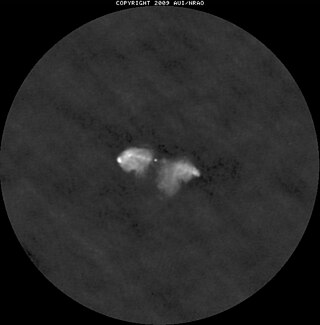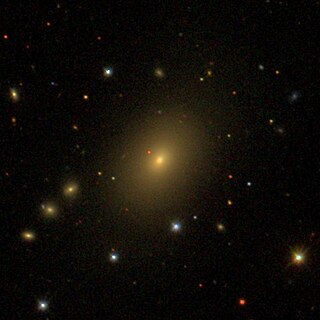
A radio galaxy is a galaxy with giant regions of radio emission extending well beyond its visible structure. These energetic radio lobes are powered by jets from its active galactic nucleus. They have luminosities up to 1039 W at radio wavelengths between 10 MHz and 100 GHz. The radio emission is due to the synchrotron process. The observed structure in radio emission is determined by the interaction between twin jets and the external medium, modified by the effects of relativistic beaming. The host galaxies are almost exclusively large elliptical galaxies. Radio-loud active galaxies can be detected at large distances, making them valuable tools for observational cosmology. Recently, much work has been done on the effects of these objects on the intergalactic medium, particularly in galaxy groups and clusters.

3C 449 is a low-redshift Fanaroff and Riley class I radio galaxy. It is thought to contain a highly warped circumnuclear disk surrounding the central active galactic nucleus (AGN). The name signifies that it was the 449th object of the Third Cambridge Catalog of Radio Sources (3C), published in 1959.

3C 20 is a radio galaxy located in the constellation Cassiopeia. It is one of largest known galaxies with a diameter of 850,000 ly (260 kpc). The galaxy features a prominent double hotspot in its eastern lobe. An unusually low fraction of the flux lies within the radio core, which is suggested to be caused by a combination of factors, including jet orientation, synchrotron self-absorption and aging, as well as interactions with surrounding gas and dust.

Ursa Major B or 3C 244.1 is a radio galaxy located in the constellation Ursa Major.

3C 285 is a radio galaxy located in the constellation Canes Venatici. It is located about 1 bilion light years away. It is a Fanaroff-Riley 2 radio galaxy and is hosted in a disturbed spiral galaxy.
3C 401 is a powerful radio galaxy located in the constellation Draco. It is near the center of a rich cluster of galaxies and dominates the cluster. That is, it is the type-cD galaxy of its cluster. It has a double nucleus, indicating that it is merging with another galaxy.

3C 452 is an elliptical galaxy about 1.2 billion light years away located in the constellation Lacerta. 3C 452 is a Seyfert galaxy and a Fanaroff–Riley class 2 radio galaxy, with the radiolobes extending for about 5 arcminutes, which at the distance of 3C 452 corresponds to about 450 kiloparsecs. Fainter radio lobes extend farther away, at megaparsec scales, probably created during a former period of elevated nuclear activity. Diffuse X-ray emission has been detected in the radio lobes.

NGC 6166 is an elliptical galaxy in the Abell 2199 cluster. It lies 490 million light years away in the constellation Hercules. The primary galaxy in the cluster, it is one of the most luminous galaxies known in terms of X-ray emissions.

NGC 708 is an elliptical galaxy located 240 million light-years away in the constellation Andromeda and was discovered by astronomer William Herschel on September 21, 1786. It is classified as a cD galaxy and is the brightest member of Abell 262. NGC 708 is a weak FR I radio galaxy and is also classified as a type 2 Seyfert galaxy.

NGC 4636 is an elliptical galaxy located in the constellation Virgo. It is a member of the NGC 4753 Group of galaxies, which is a member of the Virgo II Groups, a series of galaxies and galaxy clusters strung out from the southern edge of the Virgo Supercluster. It is located at a distance of about 55 million light years from Earth, which, given its apparent dimensions, means that NGC 4636 is about 105,000 light years across.

NGC 545 is a lenticular galaxy located in the constellation Cetus. It is located at a distance of about 250 million light years from Earth, which, given its apparent dimensions, means that NGC 545 is about 180,000 light years across. It was discovered by William Herschel on October 1, 1785. It is a member of the Abell 194 galaxy cluster and is included along with NGC 547 in the Atlas of Peculiar Galaxies.

NGC 547 is an elliptical galaxy and radio galaxy located in the constellation Cetus. It is located at a distance of about 220 million light years from Earth, which, given its apparent dimensions, means that NGC 547 is about 120,000 light years across. It was discovered by William Herschel on October 1, 1785. It is a member of the Abell 194 galaxy cluster and is included along with NGC 547 in the Atlas of Peculiar Galaxies.

NGC 7720 is an elliptical galaxy located in the constellation Pegasus. It is located at a distance of about 380 million light years from Earth, which, given its apparent dimensions, means that NGC 7720 is about 180,000 light years across. NGC 7720 is the main galaxy of Abell 2634 galaxy cluster and is a radio galaxy. It was discovered by William Herschel on September 10, 1784.

NGC 7236 is an interacting lenticular galaxy located in the constellation Pegasus. It is located at a distance of about 300 million light years from Earth, which, given its apparent dimensions, means that NGC 7236 is about 150,000 light years across. NGC 7236 forms a pair with NGC 7237 and is a radio galaxy. It was discovered by Albert Marth on August 25, 1864.

NGC 7237 is an interacting lenticular galaxy located in the constellation Pegasus. It is located at a distance of about 350 million light years from Earth, which, given its apparent dimensions, means that NGC 7237 is about 240,000 light years across. NGC 7237 forms a pair with NGC 7236 and is a radio galaxy. It was discovered by Albert Marth on August 25, 1864.

NGC 2484 is a large lenticular galaxy located in the Lynx constellation. It is situated 560 million light-years away from the Milky Way, which given by its apparent dimensions, means NGC 2484 is around 304,000 thousand light-years across. It is classified a Fanaroff and Riley radio galaxy.

4C+55.16 is an elliptical galaxy, classified type E, located in Ursa Major. The galaxy lies about 2.84 billion light-years from Earth, which means given its apparent dimensions, 4C+55.16 is approximately 445,000 light-years across making it a type-cD galaxy. It is the brightest cluster galaxy (BCG) in a cluster bearing its same name and a part of the galaxy cluster called WHL J083454.9+553421.

MRC 2011-298 is an elliptical galaxy with an active galactic nucleus, located in the constellation of Sagittarius. It is located 2.1 billion light-years away from Earth. MRC 2011-298 is the brightest cluster galaxy in the galaxy cluster, Abell 3670 and classfied as a dumbbell galaxy, an optical system with two galactic nuclei separated by 7″, corresponding to ≃17 kpc according to the adopted cosmology, with similar magnitude and a common stellar halo. The galaxy is known to have an ellipticity of ε = 0.28 and a position angle of PA = 24° that is measured from north to east.

Abell 697 BCG, also known as PGC 2079433, is a massive type-cD elliptical galaxy residing as the brightest cluster galaxy in Abell 697 galaxy cluster. It is located in the constellation of Lynx and has a redshift of 0.28, meaning the galaxy is located 3.5 billion light-years away from Earth.

















